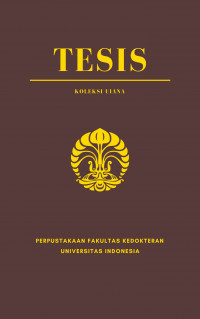Tesis
Pengaruh pemberian norepinefrin dini terhadap jumlah pemberian cairan dan kejadian overload cairan pada resusitasi pasien syok septik : kajian terhadap rasio albumin kreatinin urin, peningkatan nilai serum kreatinin, perubahan rasio pao2/fio2 dan peningkatan tekanan intraabdomen = The effect of early norepinephrine administration on the amount of fluid administered and the incidence of fluid overload in the resuscitation of patients with septic shock: a study of the urinary albumin to creatinine ratio, increases in serum creatinine values, changes in the PaO2/FiO2 ratio and increases in intraabdominal pressure.
Latar Belakang: Pasien sakit kritis dengan sepsis biasanya menerima volume cairan yang sangat besar menyebabkan balans cairan positif yang sangat signifikan dalam upaya untuk memenuhi kebutuhan kardiak output, tekanan darah sistemik, dan perfusi ke ginjal. Kondisi ini juga ternyata berkaitan dengan angka survival yang buruk. Tujuan dari penelitian ini adalah untuk mengetahui apakah rumatan dini norepinefrin dapat mengurangi pemberian cairan dan mencegah overload pada resusitasi pasien syok septik. Metode :Penelitian ini merupakan penelitian uji klinis acak tidak tersamar dengan subjek penelitian adalah pasien dewasa yang masuk di unit perawatan intensif dan instalasi rawat darurat dari Januari- November 2020 yang didiagnosa dengan syok septik. Terdapat dua kelompok perlakuan, kelompok norepinefrin dini dan kelompok resusitasi cairan 30 ml/kgBB. Dilakukan penilaian terhadap rasio albumin kreatinin urin, peningkatan nilai serum kreatinin, rasio PaO2/FiO2, dan tekanan intraabdominal pada saat diagnosa syok septik ditegakkan, 3 jam dan 24 jam setelah perlakuan diberikan. Data diolah dalam menggunakan perangkat SPSS. Hasil : Berdasarkan analisis didapatkan perbedaan yang bermakna untuk semua variabel penelitian pada kelompok perlakuan resusitasi cairan dibandingkan dengan kelompok norepinefrin. Jumlah pemberian cairan pada kelompok norepinefrin dini rata-rata adalah 2198,63 ml, lebih sedikit dibandingkan pada kelompok resusitasi cairan 30 ml/kgBB dengan rata-rata 3999,30 ml, uji Chi Square p = 0,000. Dengan membandingkan hasil pengukuran terhadap nilai pengukuran awal pada kedua kelompok, overload cairan sangat berisiko terjadi pada kelompok resusitasi cairan 30 ml/kgBB. Didapatkan hubungan yang bermakna pada rasio albumin kreatinin urin, peningkatan nilai serum kreatinin, rendahnya rasio PaO2/FiO2 dan peningkatan tekanan intraabdominal dengan pemberian resusitasi cairan 30 ml/kgBB yang menunjukkan risiko terjadi overload cairan (OR 48,273 ; CI 95% = 16,708-139,472, OR = 73,381 ; CI 95% = 19,955-269,849, OR = 12,225 ; CI 95% = 5,290-28,252, dan OR = 32,667 ; CI 95% = 10,490-101,724). Kesimpulan : Pemberian norepinefrin dini dapat mengurangi pemberian cairan dan mencegah overload pada resusitasi pasien syok septik
Kata Kunci : syok septik, norepinefrin dini, overload cairan
Background: Critically ill patients with sepsis usually receive a very large volume of fluids causing a very significant positive fluid balance in an effort to meet the needs of cardiac output, systemic blood pressure, and perfusion to the kidneys. This condition also turns out to be associated with poor survival rates. The aim of this study was to determine whether early maintenance of norepinephrine can reduce fluid administration and prevent overload in the resuscitation of patients with septic shock. Methods: This study is a randomized, non-blind clinical trial with the subject of the study being an adult patient diagnosed with septic shock who were admitted to the intensive care unit and emergency care unit from January to November 2020 who were diagnosed with septic shock. There were two treatment groups, the early norepinephrine group and the 30 ml/kgBW fluid resuscitation group. An assessment of the urinary albumin to creatinine ratio, increased serum creatinine value, PaO2/FiO2 ratio, and intraabdominal pressure at the time of diagnosis of septic shock was established, 3 hours and 24 hours after the treatment was given. The data is processed using the SPSS device. Results: Based on the analysis, it was found that there were significant differences for all study variables in the fluid resuscitation group compared to the norepinephrine group. The amount of fluid administration in the early norepinephrine group averaged 2198.63 ml, less than that in the 30 ml / kgBW fluid resuscitation group with an average of 3999.30 ml, Chi Square test p = 0.000. By comparing the measurement results against the initial measurement values in the two groups, fluid overload was very risky in the 30 ml / kgBW fluid resuscitation group. There is a significant relationship between the urinary albumin to creatinine ratio, the increase in the serum creatinine value, the low PaO2/FiO2 ratio and the increase in intraabdominal pressure with the provision of 30 ml/kgBW fluid resuscitation which indicated the risk of fluid overload (OR 48.273; 95% CI = 16.708-139.472, OR = 73,381; 95% CI = 19,955-269,849, OR = 12,225; 95% CI = 5,290-28,252, and OR = 32,667; 95% CI = 10,490-101,724). Conclusion: Early norepinephrine administration can reduce fluid administration and prevent overload in the resuscitation of patients with septic shock.
Keywords: septic shock, early norepinephrine, fluid overload
- Judul Seri
-
-
- Tahun Terbit
-
2021
- Pengarang
-
Romi Akbar - Nama Orang
Yohanes George - Nama Orang
Amir S. Madjid - Nama Orang - No. Panggil
-
T21086fk
- Penerbit
- Jakarta : Sp-2 Anestesiologi dan Terapi Intensif., 2021
- Deskripsi Fisik
-
xix, 110 hal; ill; 21 x 30 cm
- Bahasa
-
Indonesia
- ISBN/ISSN
-
-
- Klasifikasi
-
NONE
- Edisi
-
-
- Subjek
- Info Detail Spesifik
-
Tanpa Hardcopy
| T21086fk | T21086fk | Perpustakaan FKUI | Tersedia |


Masuk ke area anggota untuk memberikan review tentang koleksi